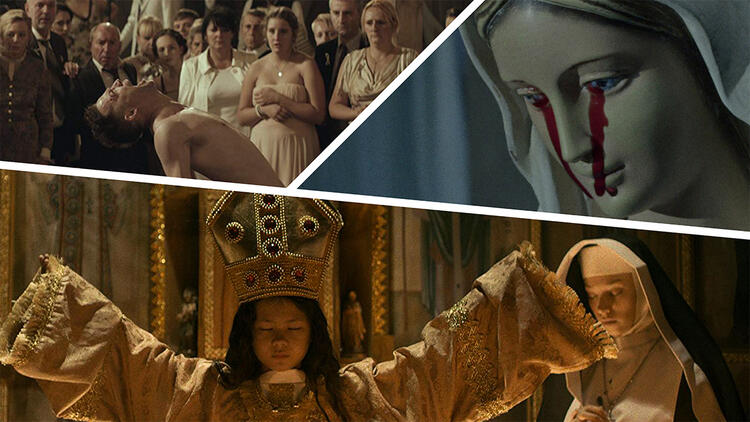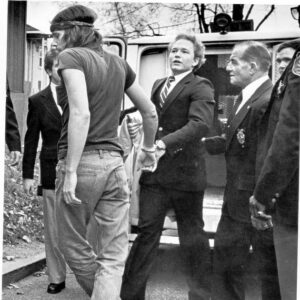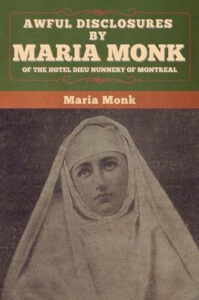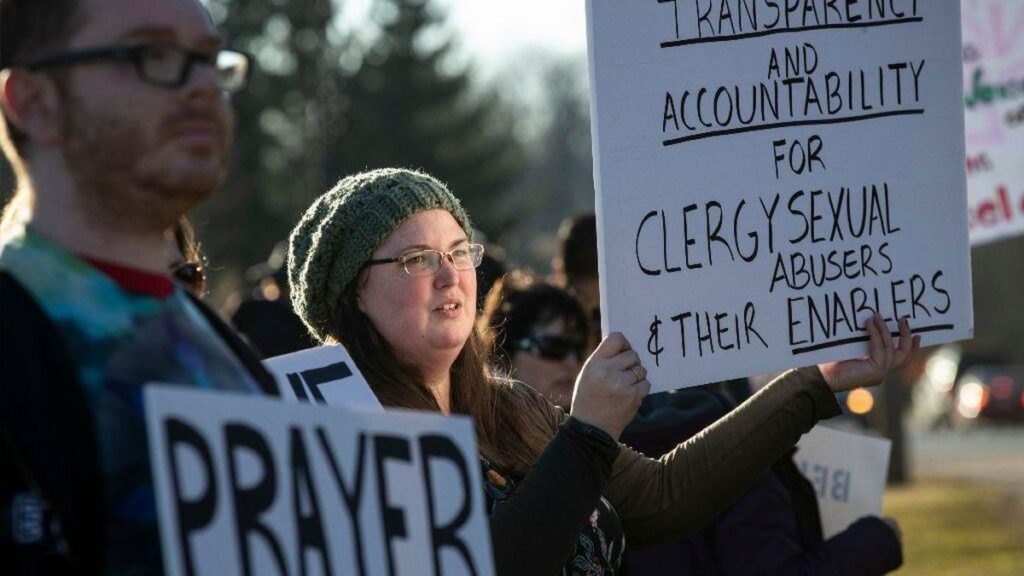Catholic Monstrosities, Priests, and Supernatural Dread
Part one of a three-part series comparing Catholic horror films and literature to actual horrors committed by the Catholic Church

(Image credit: Ciaran Freeman for IMBD)
About the Catholic Horrors Series: For the past two centuries, Catholicism has played a special role in American horror stories. During that time, the Catholic Church has also been complicit in real-life horrors. In this three-part series, three scholars of American Catholicism – Jack Lee Downey, Matthew Cressler, and Kathleen Holscher – consider Catholic horror as a cinematic and literary genre alongside horrors committed by the Catholic Church and its leaders. Through this series, they explore the intersections of horror as an aesthetic and as a way to analyze and confront the shadow side of Catholicism in North America.
***
“The oldest and strongest emotion of mankind is fear, and the oldest and strongest kind of fear is fear of the unknown.” – HP Lovecraft, “Supernatural Horror in Literature”
On a crisp winter day in 1981 in Brookfield, Connecticut, nineteen-year-old Arne Cheyenne Johnson stabbed his landlord Alan Bono to death with a pocketknife. Bono was a manager at Brookfield Boarding Kennels, where Johnson’s girlfriend, Debbie Glatzel, worked as a dog groomer. They’d gone as a group for a bite at a local pub called the Mug ‘N’ Munch. Bono had been drinking heavily throughout the meal and started behaving erratically, at one point aggressively grabbing ahold of Glatzel’s little sister. At this, Johnson began growling like a wild animal and sank his five-inch blade into Bono’s gut and chest several times. It was a shocking scene, but the incident only grew weirder. At the murder trial, Johnson’s lawyers claimed Johnson had been deranged by virtue of demonic possession.
The “Devil Made Me Do It” case, as it came to be known, drew international attention almost immediately, with its mix of alleged supernatural evil and homicidal gore. The New York Times reported the story as an Exorcist-style murder mystery, emerging “at a time when there is growing belief across the nation in various forms of the occult.” But, in Brookfield, some believed this tragedy had actually been a longtime coming. For upwards of a year, Debbie Glatzel’s brother, David, had been possessed by the very same demon. His Catholic family had gone to a local priest, who in turn enlisted the help of the clairvoyant/demonologist couple, Lorraine and Ed Warren. The Warrens concluded that the demon had attached to the Glatzel family during Debbie and her mother’s experimentation with witchcraft during a snowmobiling vacation. David was caught in a constant cycle of agony. Following several unsuccessful exorcisms, in a fit of sympathetic desperation, Arne Johnson challenged the demon to “Take me on instead of him.” As Ed Warren would later note, “It’s just one of those things you never do… Not if you know anything about this sort of thing.”

(Arne Johnson. Image source: Courant File Photo)
In the grainy black-and-white trial photos, Johnson looks like he could have been a middle-aged banker or local politician instead of a teenage landscaper. Dressed in a plaid blazer and slacks, and sporting a slightly-floofed helmet of blond Aqua Net hair, he seems an unlikely candidate for demonic possession – as unlikely as Brookfield, Connecticut seems a vortex for the malevolent supernatural. In the end, Johnson was convicted of manslaughter, sentenced to ten-to-twenty years in prison, and released after four. Although Johnson and Glatzel eventually disappeared from the spotlight, their story of demonic possession continued to haunt the public imagination and was recently revived in the third installment of the Conjuring film franchise, The Conjuring: The Devil Made Me Do It (2021), starring Vera Farmiga and Patrick Wilson as Lorraine and Ed Warren.
Catholicism has proven an enduring wellspring of dread in American culture. As sadistic villains and supernatural heroes, Catholics have been a primordial element in horror literature, cinema, and news media. Monster theorists (they exist) suggest that examining who and what a society deems “monstrous” is critical to understanding its values and preoccupations, and that the horror genre allows for the recognition of terrors that we conventionally repress precisely because they are so repellent. Film critic Robin Wood writes that, “One might say that the true subject of the horror genre is the struggle for recognition of all that our civilization represses or oppresses, its re-emergence dramatized, as in our nightmares, as an object of horror, a matter for terror, and the happy ending (when it exists) typically signifying the restoration of repression.” Catholicism has been an object of both fascination and revulsion in American popular culture, and Catholic horror illuminates conventionally repressed anxieties about the presence of supernatural evil in the modern world, as well as how the Catholic Church perpetuates its own traditions of violence.
Terror Behind the Walls
“Infants were sometimes born in the convent: but they were always baptized and immediately strangled! This secured their everlasting happiness; for the baptism purified them from all sinfulness, and being sent out of the world before they had time to do any thing wrong, they were at once admitted into heaven. How happy, she exclaimed are those who secure immortal happiness to such little beings! Their little souls would thank those who kill their bodies, if they had it in their power!” – Maria Monk, The Awful Disclosures of the Hôtel Dieu Nunnery of Montreal
Stories of forced captivity have been essential to Catholic horror. In the antebellum period, as immigration from Europe – particularly Germany and Ireland – swelled, northeastern U.S. urban centers witnessed an exponential growth in Catholic population and civic power. This period of the so-called “Immigrant Church” was foundational for “ethnic white” Catholic identity, owing to both a surge in numbers and the concomitant xenophobic backlash it engendered.
As ascendant Catholic power grew, Protestant anxieties about invasive hordes of tired-hungry-poor foreigners disrupting the American way of life inspired creative anti-Catholic fantasies about diabolical and seditious papist conspiracies. Nerves occasionally boiled over into nativist riots, which included the arsons of two churches and the shelling of another during the Philadelphia summer of 1844. But the tactical predecessor of the Philadelphia church burnings was an assault on a convent in Boston, under the guise of rescuing a runaway nun who locals believed was being tortured just behind the enclosure’s walls.
The years that followed the siege of the convent witnessed a proliferation of convent captivity literature. This included Six Months in a Convent, a memoir by Rebecca Reed, an Episcopalian turned Catholic postulant with the Charlestown Ursulines. Reed’s tell-all, composed and circulated locally prior to the riot, and published just the year after (1835), depicted convent life as sadistically carceral and depraved. Reed’s memoir was a survivor’s warning against the allure of Roman Catholicism to unsuspecting Protestants: “If, in consequence of my having for a time strayed from the true religion, I am enabled to become an humble instrument in the hands of God in warning others of the errors of Romanism; and preventing even one from falling into its snares, and from being shrouded in its delusions, I shall feel richly rewarded.”
 Six Months in a Convent was a runaway success, selling over 200,000 copies in its first month. However, it was eclipsed the following year by another convent captivity memoir, The Awful Disclosures of the Hôtel Dieu Nunnery of Montreal, written under the nom de plume “Maria Monk.” The broad strokes of Monk’s tale mirrored Six Months: another young Protestant woman duped into converting to Catholicism and taking the veil, only to escape and expose the dark underbelly of popery. Awful Disclosures amplified the dramatic content, transfiguring the “Black Nuns” convent into a sex trafficking ring. Noncompliant sisters were punished by being thrown into solitary confinement in squalid subterranean cells, and upon pregnancy, carried their babies to term only to have them immediately baptized, strangled, and tossed into a lime pit in the convent basement. Priests used the confessional to groom victims, wielding the authority of their office: Monk said she was taught that priests could not sin, and therefore their commands were to be treated as God’s own, no matter how vile. It was a repulsive, terrifying depiction of Catholic religious life. And the American public lapped it up. Awful Disclosures moved more freight than any other book in the country’s history besides the Bible, at least until the publication of Uncle Tom’s Cabin in 1850. Abhorrent as Monk’s descriptions of illicit Catholic sex and torture were, Protestants found them profoundly titillating.
Six Months in a Convent was a runaway success, selling over 200,000 copies in its first month. However, it was eclipsed the following year by another convent captivity memoir, The Awful Disclosures of the Hôtel Dieu Nunnery of Montreal, written under the nom de plume “Maria Monk.” The broad strokes of Monk’s tale mirrored Six Months: another young Protestant woman duped into converting to Catholicism and taking the veil, only to escape and expose the dark underbelly of popery. Awful Disclosures amplified the dramatic content, transfiguring the “Black Nuns” convent into a sex trafficking ring. Noncompliant sisters were punished by being thrown into solitary confinement in squalid subterranean cells, and upon pregnancy, carried their babies to term only to have them immediately baptized, strangled, and tossed into a lime pit in the convent basement. Priests used the confessional to groom victims, wielding the authority of their office: Monk said she was taught that priests could not sin, and therefore their commands were to be treated as God’s own, no matter how vile. It was a repulsive, terrifying depiction of Catholic religious life. And the American public lapped it up. Awful Disclosures moved more freight than any other book in the country’s history besides the Bible, at least until the publication of Uncle Tom’s Cabin in 1850. Abhorrent as Monk’s descriptions of illicit Catholic sex and torture were, Protestants found them profoundly titillating.
Catholics had no monopoly on antebellum Protestant anxiety, but urban Catholics were proximate-other enough that their threat felt imminent. Catholics walked among Anglo-Protestants and might lure unsuspecting naïfs through convent walls, behind which all manner of danger – physical, psychological, spiritual, sexual – lurked. Catholic horrors were close. Although white Catholics might well pass as everyday Americans – and increasingly that’s exactly what they would become – white Protestants believed Catholic religious life was fraught with sexual deviance, gender ambiguity, sedition, and apostasy.
Catholic Heroes
“Hordes of prowlers reel shouting and singing along the lanes and thoroughfares, occasional furtive hands suddenly extinguish lights and pull down curtains, and swarthy, sin-pitted faces disappear from the windows when visitors pick their way through. Policemen despair of order or reform, and seek rather to erect barriers protecting the outside world from the contagion.” – HP Lovecraft, “The Horror of Red Hook”
As an NYPD detective, HP Lovecraft’s fictitious Thomas Malone gravitated towards life’s shadow side. The macabre of the everyday always felt close to him. And so it made perfect sense that he would be detailed to a phantasmagorical Red Hook, Brooklyn, a “tangle of material and spiritual putrescence” where “the blasphemies of an hundred dialects assail the sky.” But his investigation into a mysterious recluse named Robert Suydam would drag him down a rabbit hole that left Malone psychologically and spiritually frayed almost beyond recognition.
HP Lovecraft’s 1924 fictional short story “The Horror at Red Hook” is a satanic kidnapping and child-sacrifice mystery set on the Brooklyn waterfront. Its protagonist, the Dublin-born and implicitly Catholic Malone, is assigned to investigate rampant lawlessness among the throngs of uncivilized dark “Asiatics” who had transformed Red Hook into a den of vice and, Malone suspected, the occult. “The Horror at Red Hook” is not about Catholicism per se, but more broadly a work of creative xenophobic paranoia that deploys a liminal Irish Catholic cultural shapeshifter who moves between polite Anglo society and the “babel of sound and filth” that was the Brooklyn waterfront. As an Irishman congenitally disposed towards the paranormal, Malone was uniquely suited to investigate the “creatures” who gathered in underground caverns beneath a decrepit Catholic church.
Lovecraft, who stands alongside the likes of Edgar Allen Poe and William Peter Blatty in the pantheon of horror writers, was an unselfconscious bigot. NK Jemisin, author of The City We Became – conceived in conversation with Lovecraft – put it bluntly: “He was a notorious racist and horrible human being.” Lovecraft’s collected works and personal writings are littered with racial epithets and casual references to non-Anglos as ogrish and bestial. “The Horror at Red Hook” is the most bluntly racist of Lovecraft’s published stories. Recent years have seen the horror literature community reckon, sometimes quite publicly, with Lovecraft’s racist legacy. While Lovecraft is notorious for his existential contemplations of human insignificance, China Miéville sees Lovecraft’s racism as foundational to his full spectrum of creative writing: “[I]t is race hatred that raises in him the poetic trance … So, in other words, the antihumanism one finds so bracing in him is an antihumanism predicated on murderous race hatred.”
Lovecraft was a proud hibernophobe who mocked Irish sovereignty aspirations as the quixotic fever dreams of the Emerald Isle’s “brainless canaille.” Even so, he found Irish Americans useful inbetweeners – one foot in civilization, the other in the gutter. By the time Lovecraft penned “The Horror at Redhook,” Catholics had mainstreamed considerably, but not conclusively. Descendants of Potato Famine refugees assimilated into mainstream white society and gained political heft through their blood sacrifice in the Civil War, prodigious birthrates, labor monopolies, and unholy alliances like redlining. But three years after the publication of “The Horror at Redhook,” the first viable Catholic presidential candidate, Al Smith, would see his campaign shredded by suggestions that as a papist Smith was not, in fact, a free agent – even though he was famously illiterate on fundamental Catholic doctrine – charges that would be less successfully levied against John F. Kennedy thirty years later. But in the 1920s, the liminal Thomas Malone is Lovecraft’s upwardly-mobile infidel who is able to access a cosmic underworld of human sacrifice, psychedelic chaos, and undead resurrection. As a genre character, Malone is a transitionary figure, in which Catholics morph from vessels of supernatural evil to their adversaries. And yet, Red Hook remains immutable: “The soul of the beast is omnipresent and triumphant, and Red Hook’s legions of blear-eyed, pockmarked youths still chant and curse and howl as they file from abyss to abyss…”
A Different Kind of Captivity
By the tail end of the 1970s, Catholic supernaturalism dominated horror cinema. The 1973 film adaptation of William Peter Blatty’s The Exorcist cemented the demon-possession-as-spiritual-captivity-narrative trope and barnstormed American cinema as part of a quartet of blockbusting Catholic supernatural horror, alongside Rosemary’s Baby (1968), The Omen (1976), and The Amityville Horror (1977). In pop imagination, Catholics, priests in particular, had been recast as the last line of defense against primitive evil – often unleashed from some arid far-off land – in an American culture that remained anxious about supernatural presence even as it nominally presumed to evolve beyond such superstition.
The knightly Catholic priest had become so integrated into the American collective unconscious by the first decade of the new millennium that director Scott Stewart was able to wield a $60M budget for a saga about a warrior-monk (named “Priest,” played by Paul Bettany) with a massive “cross potent” tattooed on his face. A dark, ragged, futuristically-steampunk supernatural western, Priest narrates a rescue mission, as Priest-and-company attempt to save his daughter from feral vampires. Adapted from a Korean manhwa comic and self-consciously styled after The Searchers (1956), Stewart constructed a desolate captivity narrative with vampires replacing the Comanche and a heavily armed cleric as liberator. Although Stewart claimed his film was not based on “this world’s Church,” he deployed Catholic symbolism – not just crosses, but Confession, rosaries, prayers, Communion – as a universally recognizable generic for militant supernaturalism, embodied by a mendicant vampire-slaying John Wayne.
For all its “vampocalyptic” theatrics, Priest was eclipsed in the box office by a series of films about a married couple from suburban Connecticut: the 1981 Arne Johnson murder trial made celebrities out of Ed and Lorraine Warren, and undergirded the Conjuring film franchise, which has grossed over $2 billion since 2013. As Vatican II-era paranormal detectives, the Warrens’ vocation to spiritual warfare fired American imaginative synapses, even, perhaps especially, among their many skeptics. Chronicler Gerald Brittle would describe the “Devil Made Me Do It” episode as “the worst case of their lives,” but it was also a career-maker, ultimately transforming the Warrens into icons of contemporary “based on a true story” horror. And as revelations of rampant clerical abuse have rendered the default setting of priest-as-hero increasingly noxious, the married couple has found a second life as family-next-door demon hunters.
It Happened Everywhere
“We, the members of this grand jury, need you to hear this. We know some of you have heard some of it before. There have been other reports about child sex abuse within the Catholic Church. But never on this scale. For many of us, those earlier stories happened someplace else, someplace away. Now we know the truth: it happened everywhere.” – Report I of the 40th Statewide Investigating Grand Jury (Pennsylvania)
In August 2018, a Pennsylvania grand jury released a report on the findings from its two-year long inquiry into sexual abuse perpetrated by Roman Catholic priests in Pennsylvania. The report covered six of the state’s eight dioceses – excluding the previously-investigated Philadelphia and Altoona-Johnstown. The report’s introduction was a graphic, visceral, and traumatized plea. The grand jury uncovered over a thousand child victims of abuse, and over three hundred “predator priests,” but stipulated that “[w]e believe that the real number – of children whose records were lost, or who were afraid to come forward – is in the thousands.” The text included anecdotal narratives – such as that of a priest who raped a convalescing child while visiting her in the hospital; and another who forced a nine-year-old to perform oral sex and then rinse his mouth out with holy water – before acknowledging an ominous conceit: “We should emphasize that, while the list of priests is long, we don’t think we got them all.”

(Photo credit: John Konstantaras/Chicago Tribune)
Even in the post-Spotlight “Catholic Abuse Crisis” world, the Pennsylvania grand jury report still stunned many with the revelation that sexual abuse and its cover-ups had been a norm, rather than an exception, in Catholic life. But of course not everyone was shocked. As Indian Country Today noted, “American Indians know all too well the devastating impacts of such institutional perversion, and as a result, express both empathy and sympathy for the victims of these heinous crimes.” Scholars of Catholicism, with few exceptions, have not been as discerning.
At a 2019 historian’s conference, William Cossen challenged the conventional wisdom to describe Maria Monk and other similar stories as simply a genre of “anti-Catholicism.” As a matter of course, scholars have roundly dismissed Monk and Rebecca Reed as fraudulent avatars for Protestant xenophobia. But in the wake of the Pennsylvania grand jury, Cossen questioned whether, in their reflexive deprecation of convent tales, historians had inadvertently served as “aiders and abettors” of abuse.
In this period of public attentiveness to clerical abuse, Catholic horror cinema has witnessed something of a return to form with priest villains counterbalancing the Exorcist-style cosmic superheroes. Although there continues to be an appetite for supernatural horror, as in the Conjuring trilogy, there has been a proliferation of dramas and biopics dramatizing the Church’s real-life terrors – most notoriously 2015’s Spotlight. But there have also been creative imaginings of Church institutional violence that reflect collective revulsion to the perpetually mounting documentary evidence. 2013’s Rhymes for Young Ghouls depicts St. Dymphna’s residential school on the fictionalized “Red Crow” Mi’kmaq reserve, where Indigenous children were tortured, sexually abused, and stripped of cultural connection and community. More recently, the miniseries Midnight Mass fuses Catholic horror blueprints by investigating the figure of the priest as both an agent of healing and death.
Contemporary Catholic captivity narratives – from tales of kidnapping to demonic possession – terrify and entertain, while also revealing something about both our existential dread and the monsters among us; beckoning us, in the words of philosopher Eugene Thacker, to “confront an absolute limit to our ability to adequately understand the world at all.”
Jack Lee Downey is the John Henry Newman Professor in Roman Catholic Studies at the University of Rochester. He is the author of The Bread of the Strong: Lacouturisme and the Folly of the Cross, 1910-1985 from Fordham University Press.